HSwMS Oscar II was a coastal battleship (Panzerkepp) of the Swedish Navy built before WWI. She was larger, more powerful, and better protected than any other that came before, setting a new standard for Scandinavia. She had an important role during WWI by covering the Swedish invasion of Åland from February to April 1918, while maintaining a potent neutrality deterrence, from her commissioning to the end of WW2 as well. Moernized in the interwar, she indeed provided the required strenght to the coastal fleet with updated system, and even saw service years into the cold war as TS then harbour ship. When she was discarded at last in 1974 Oscar II was 60 years old, quite a feat for any warship, and the very last of her kind in the world.
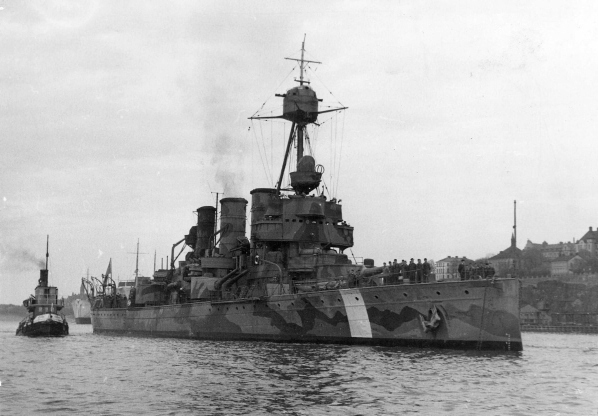
Oscar II in WW2, with green-tones “forested island camouflage” and neutrality bands.
Design development of Oscar II
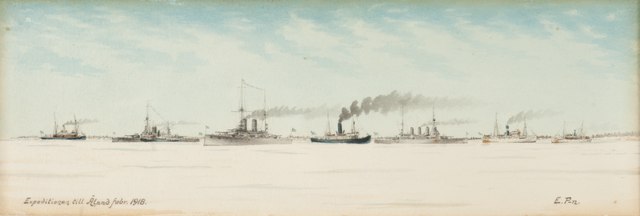
Museum painting, the Swedish fleet prior to WWI.
Oscar II was essentally seen as a natural development of the preceding Äran-class coastal defence ship, four ships launched in 1901-1903 and replacing the previous HSwMS Dristigheten (1900) and the three Panzerkepp of the Oden-class of 1894-99. This was an incremental development really started back in 1901 when Sweden appointed a commission to analyse the state of naval defence and setup requirements for future ships to meet its needs. The commission looked at other countries, seeinf the Anglo-German naval arms race and quickly ruled out the hazardous path of building a comparable battleship. Indeed the latter were perceived as fit for a long range projection of power in open seas, but a defensive battleship obeyed quite different rules.
While previous coastal battleships has been short range coastal defence vessels seen as merely an extension of the shore fortifications and minefields, a larger, better armed and protected vessel still could sacrifice speed, not required, and instead capitalized on a lower draft and freeboard, better adapted to the nature of the island mazes close to the shore, exploiting the tactical advantages of the Swedish archipelago. This was the confrmation of the path chosen ten years ago, but updated with the latest gunnery and protection innovation to be able to deal with potentially modern enemy ships.
As it turned out, when this Panzerkepp was defined in the great lines, the commission proposed three alternatives to the government:
- 1- 4,800 tonnes and four 21 cm (8.3 in) guns, 18 knots
- 2- 3,950 tonnes and two 21 cm guns, 17 knots
- 3- 4,218 tonnes and two 21 cm guns, 18 knots
Strangely the Admiralty preferred the second, which was the cheapest of all three, but the parliament (Riskdag) voted for the third on the recommendation of Louis Palander, Naval Secretary, which was the fastest. The larger, more potent twin turret solution was ruled out. The caliber was the largest Bofors was caable of producing at the time. These were smaller than the 10 inches guns produced for the 1890s Oden class, but they had a much longer barrel for a greater range, and fired much faster, which compensated for the smaller caliber. They were superior for example to the 8-in guns produced at the time, found on armoured cruisers, and equivalent to the German Schwere Kreuzer of the time.
The design was further worked out on the base of the Äran design with minor alterations, but the parliament wanted to increas the auxiliary artillery, armour and speed. And from the preparing new designs and coordination to refine the design, this proceeded for almost two years. It’s only in May 1903 the king approved drawings for his namesake capital ship, on 22 May 1903. Order was placed at Lindholmens Mekaniska Verkstad in Gothenburg on 23 September. The design blueprints were further refined and finally ready in 1904. The contract was obtained by Lindholmen’s shipyard, in Gothenburg. The keel was laid down probably in mid-1904 (date unknown), and she was launched on June 6, 1905. Fitting out work was done, followed by sea trials, and post-trial fixes until the ship could be offically commissioned on April 3, 1907, so quite late after her launching, and almost seven years after her design was finalized, so she was already obsolescent. Her cost was SEK 3,390,000, well above all previous ships, and less than the initially planned 6,225,800 kr but in adjusted value.
Design of Oscar II

Painting, scene made from her open admiral bridge, showing the Engine order telegraph
As a modernised and slightly larger version of the Äran-class, Oscar II displaced 4,584 tonnes (4,512 long tons) fully loaded, but normal displacement was 4,273 tonnes (4,206 long tons), with a waterline length of 95.6 m (313.6 ft), 15.4 m (50 ft 6 in) beam and 5.49 m (18 ft) draught. These values are conformed by Conways. Her normal complement was 326 officers and ratings but she ws fitted to act as a command staff, with a specific admiral bridge and extra accomodation for nine officers. Design wise for her general outline, she was a reasonably sound design for the Baltic sea, with a relatively low-freeboard flsush deck hull raised at the bow, fitted with a ram.
Her lines were relatively rounded, with a progressive beam on a symetrical design fore and aft, two axial main turrets completed by four turrets, not installed on the battery corners, but further inside cutouts amidships. The latter battery deck hosting tertiary guns. She also had two masts when completed, both pole ones, the forward supporting a small covered spotting top. Service boats were installed alongside the funnels, with davis. The aft mast also had a service boom. Se would be modified many times in her career but not completely reconstructed as some ships on the Swedish Navy.
Powerplant
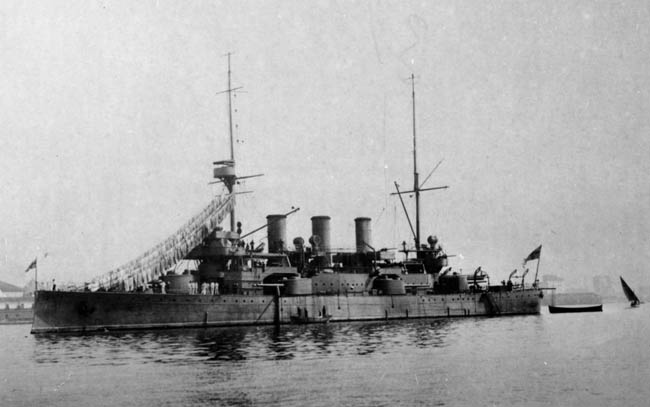
Oscar II as completed, notice the forward pole mainmast, soon replaced.
Oscar II was given two four-cylinder triple expansion steam engines (VTE) provided by Motala Verkstad. Each drove a three-bladed propeller. Steam came at a working pressure or 16.5 kg/cm2 (235 lb/sq in) from ten Yarrow water-tube boilers. They were distributed into three separate rooms as a flooding protection measure, with watertight doors.
The engines global output reached 9,400 shaft horsepower (7,000 kW) in normal conditions, probably around 9,800 with overheating. She carried Coal, a total of 490 long tons (500 t), making enough at her consumption rate for a range of 3,550 nautical miles (6,570 km; 4,090 mi) at 11 knots which was sufficient for her coastal role, but she can also speed up and maintain a range of 1,100 nmi at 17.8 knots.
On sea speed trials, she reached 18.14 knots (33.60 km/h; 20.88 mph), burning 0.95 kg/h (2.1 lb/h) per horsepower, which was not too bad. She famously was the sole Swedish coastal battleship with three funnels, so she earned nicknames such as “tre rör” (three pipes).
Armour scheme
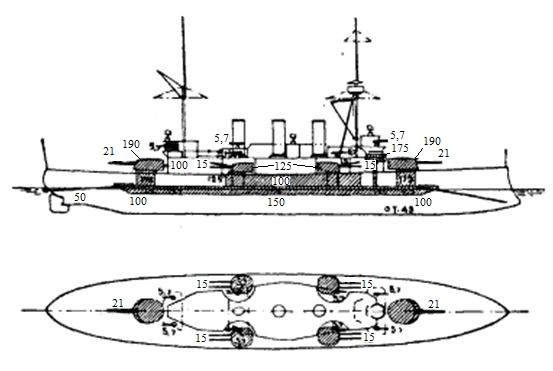
General armour scheme on Brasseys. Note this was the already updated version with the tripod mast (so after xxx)
The major change compared to the previous Äran class was the side armour was taken to the upper deck for a short distance amidship. Her armour therefore was an improvement, especially when the lower decks were not forgotten either. In short:
- Main belt on 67 m (219 ft 10 in), Schneider-Creusot steel 150 mm (5.9 in) amidships
- Fore and aft tapered down belt: 125 mm (4.9 in), then 100 mm (3.9 in) both forward and aft
- Citadel 23 m (75 ft 6 in) long, 100 mm thick
- Main Barbettes 175 mm (6.9 in) rings
- Main deck 22 mm (0.9 in) mounted on 22 mm steel plate
- Forward Conning tower 157 mm (6.2 in) walls thick
- Aft conning tower 100 mm
- Bridge 10 mm (0.4 in)
- Upper deck 57 mm (2.2 in) thick
- Turrets 125 mm face, 60 mm sides and top (2.4-4.9 in)
Armament
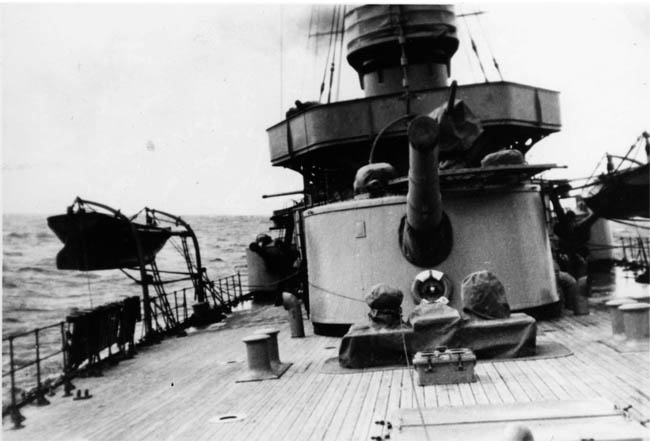
The aft gun turret and secondary ones. Lighter 57 mm are also visible.
Main: Two turreted Bofors 21 cm K/44 M98
These 210 mm (8.3 in) models were mounted in single turrets fore and aft, centreline (axis). These models were first designed in 1898 and very similar to those used by the earlier Äran class. They fired a 125 kg (276 lb) shell at a 750 metres per second (2,500 ft/s). Rate of fire was two rounds a minute. The turrets were protected by Krupp cemented armor.
Secondary armament: 8x 15,2 cm K/50 M03
The 152 mm (6 in) K/50 M03 guns were mounted in twin (solidary apparently) cradles in turrets. The barrels and mounts were provided by Bofors and also used on the armoured cruiser HSwMS Fylgia. They fired a 45 kg (100 lb) shell at 850 m/s (2,789 ft/s). Rate of fire was 2.7 shells a minute. These four turrets amidships, two per side of the superstructure were partly encased in cutouts in the main battery.
Tertiary armament: 10x 5,7 cm, 3x 3,7 cm
These ten 57 mm (2.2 in) M/98B guns were provided by Finspång. Five were placed in single mounts on either side of the bridge. In addition, three 37 mm (1.5 in) Bofors M/98 were also placed in single mounts, but tthe latter allowed them to be placed on the ship’s steam cutters to be used for fire support when landing a party ashore. In that guise, Oscar II could carry about 20 Marines complemented by armed sailors and oficers for a total of around 60 when the occasion arose, transported in one go in all the service boats. Also like all ships of her generation, Oscar II was fitted with two torpedo tubes, of the standard 450 mm (18 in) caliber, both submerged, so below the waterline fore and aft.
Oscar’s II amazing three wars career
King Oscar II was to launch his namesake ship on 6 June 1905, but a combination of a labour dispute and dissolution of the union between Norway and Sweden had it postponed until 10 June. By then, she was launched in a non-traditional way, without champagne (prohibited by Queen Sophia). But she became the Swedish warship named after a living monarch, at least since 1824. HMS started her yard trials after completion, then official trials and eventually entered service as flagship of the Swedish Navy on 3 April 1907.
Prewar service

HMS Oscar II
Oscar II departed for her shakedown cruiser the same summer 1907 in the Spithead for the coronation parade with the British Navy Home Fleet.
As the pride of the Swedish Navy, Oscar II was essentially showing the flag, making her first cruiser in England and back home, let the King sign his name on her aft conning tower, shortly before he passed out. The battleship became de facto the Swedish royalty’s yacht, visiting Saint Petersburg on 29 April 1908 with Prince Wilhelm (Duke of Södermanland) on board, on his way to marry the Grand Duchess Maria Pavlovna. Later she hosted and carried King Gustav V to Sassnitz in Germany, where on 6 July 1909 he had an official visit to Kaiser Wilhelm II.
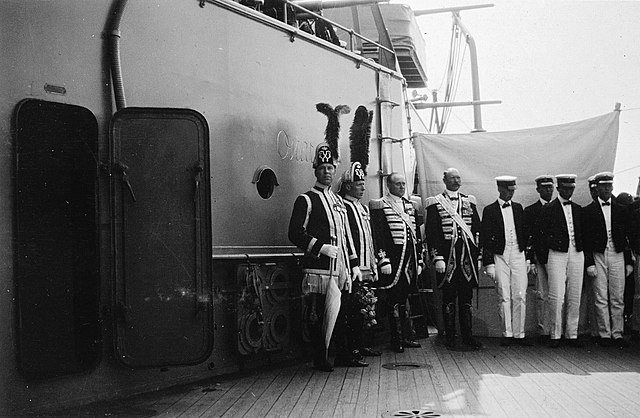
Officers on deck to receive the Tsar.
In 1909–1910 she departed for her first long cruise, to the Mediterranean sea. In fact for the next three years she would tour the Mediterranean, visiting en route Denmark, England, Germany and the Netherlands.
In 1910–1911 she had her first major overhaul: Her front mast was replaced by a tripod mast to support a new spotting top and telemeter, considerably increasing accuracy at long range. In 1911–1912, she made another long cruise, visiting northern European countries.
By May-June 1912, hse carried the King and Queen Victoria of Sweden to Finland, for an official visit of Tsar Nicholas II, and was briefly mobilised as flagship, saw the First Balkan War before being back as a “royal yacht”, bringing the King to Christian X of Denmark (June 1913). She also visited Victor Emmanuel III of Italy in July 1913. In July 1914, so close to the war, she escorted the battleship carrying President Raymond Poincaré (France).
Wartime service (WWI)
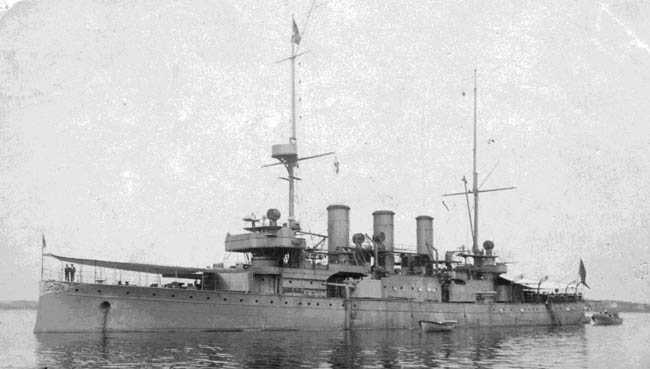
Oscar II at anchor
When WWI broke out, Oscar II had two of her 57 mm cannons replaced by two AA guns of the same caliber. The control tower was moved slightly aft also to provide better visibility forward.
As the Swedish fleet was mobilised, Oscar II was used as flagship, protecting trade routes and shipping, patrolling along the shores and the Baltic sea lanes. Neutrality ensured she spent much time in firing drills and damage control, with some fleet manoeuvers, but with nothing notable.
Oscar II participated with the new HMS Sverige in the Åland Expedition in 1918: This was her only active military action outside neutrality patrols. This expedition targeted contested islands, after Sweden’s recognition of Finnish independence. It was indeed reported atrocities against Swedish-speaking inhabitants.
Russian forces in disarray due to Russian Civil War, with both sides claiming the islands, the Swedish government saw an opportunity to occupy them. However, Germany was also interested in gaining the islands as part of a wider strategy to control the Baltic Sea and sent a substantial fleet at the same time.
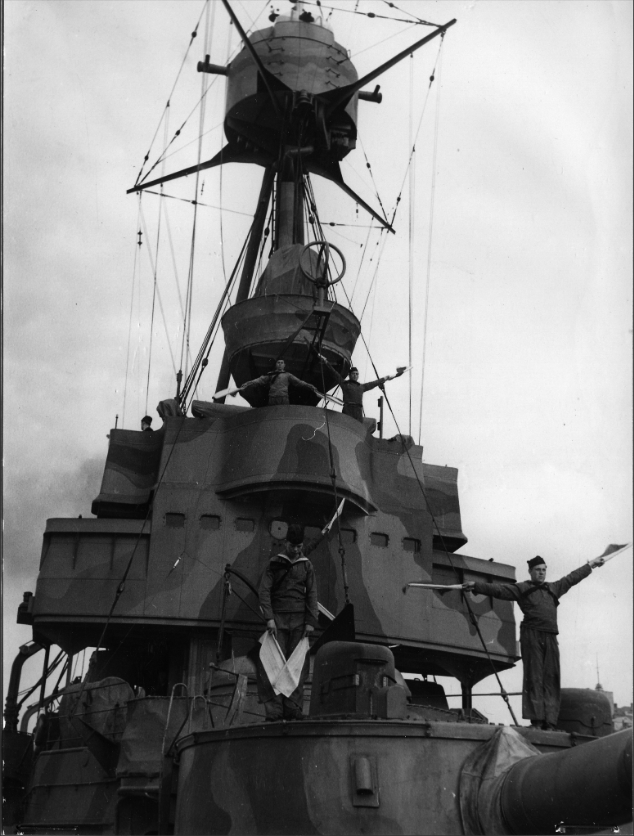
Oscar II crew signalling – credits digitalmuseum.se
Major modifications
In 1929, she saw her aft mast shortened and other minor modification that gradually changed her overall appearance, notably to the bridge. She would make five long cruises during the the interwar period.
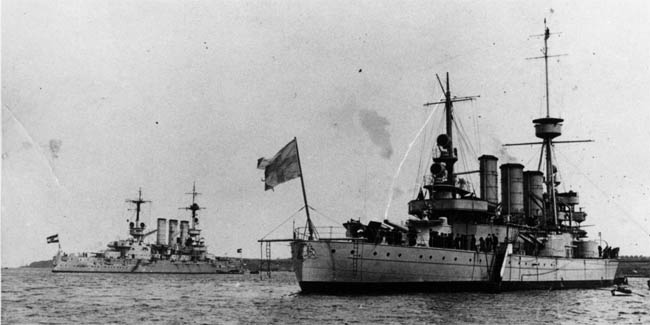
Oscar II visited Kiel 1929
Before World War II, HMS Oscar II was overhauled and also underwent her major modernization. Both her main and secondary artillery saw an increase of firing range thans to on one side, the modification of their mounts, and on the other, the installation of a better, higher central sight mounted on the tripod spotting top, and new optics from Sweden.
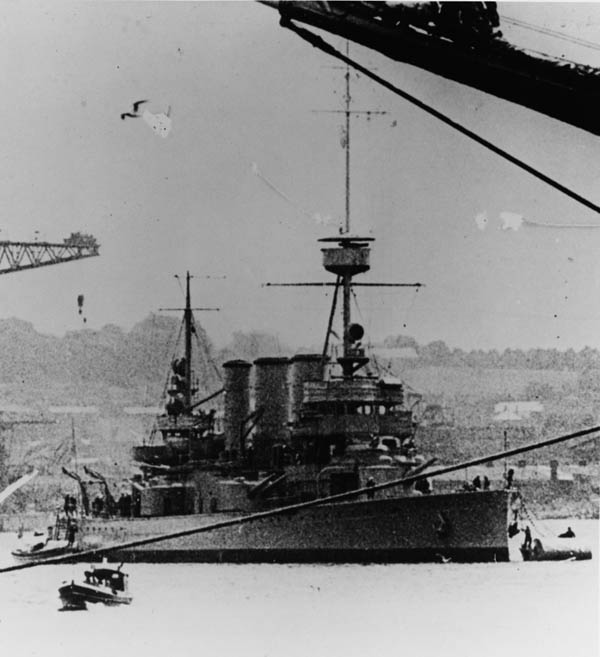
Oscar II in 1935. Credits Naval History Heritage Command
The old 57 mm guns were all replaced by modern anti-aircraft guns, four semi-automatic 57 mm Bofors, added to two 25 mm anti-aircraft guns, also from Bofors and two twin 8 mm KPV machine guns. The bridge gained a more modern intercom, a gyrocompass, the hull was fitted with a sonar, and three new searchlights were installed on platforms along the bridge and funner for night fighting. Paravanes were also added to severe mine cables.
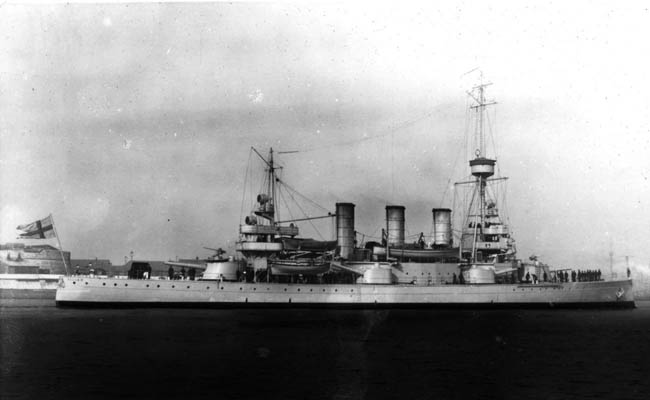
Oscar II in March 1936.
But this also concerned the ship’s inside as well: The armor deck was removed to access the machinery spaces, and new steam boilers, two oil-burning, the other modern coal-burning models were installed, with a combustion efficiency far greater, while being smaller and lighter. They also had oil heating and boost injection. However all these modification had a cost as the ship’s displacement rose of 450 tonnes.
Oscar II in WW2

Oscar II in WW2
This major refit was completed on October 30, 1939, just in time for the start of WW2. After a refresher training, Oscar II was deployed to the Karlskrona department, multiplying neutrality patrols, with white bands painted fore and aft of her hull. She kept her light grey livery until 1942-43 for a 5-tone complicated pattern also used by other vessels of the Swedish Navy to better blend on the landscape.
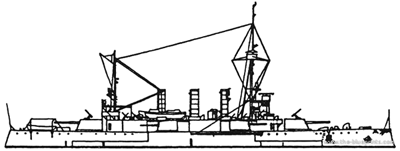
Oscar II in WW2
She was later assigned to the Stockholm Squadron, and was used to train new recruits at the Naval Academy, before reassigned to the Karlskrona department until the end of the war.
Oscar II’s cold war (1947-1974)
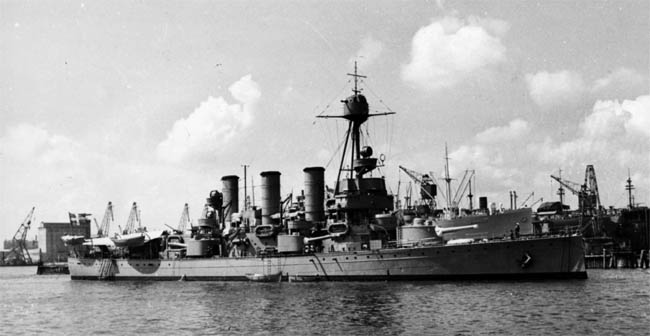
Oscar II in Gothenburg, 1946
After the war, Oscar II was in the fleet of coastal defence ships that Sweden wanted to retire. Oscar II however made a last royal journey to return home the body of Prince Gustaf Adolf (Duke of Västerbotten) died in a KLM’ DC-3 air crash at Copenhagen Airport (26 January 1947).
In 1947-49 she resumed her training service. She was ultimately decommissioned on 24 February 1950. The hull was however subsequently equipped with learning spaces and used for training managing leaks and radioactive contamination, including decontamination drills. After a further twenty-six years in service, the vessel was sold for 850,000 kr on 11 September 1974 to be broken up for scrap. Oscar II was the last coastal defence ship in the Swedish Navy, outlasting the more modern HSwMS Gustav V by four years.
Sources/Read More
narkhammar.se
flottansman.se
Old article on runeberg.org
On navypedia.org
old-navypedia.org
tugboatlars.se
worldnavalships.com
warshipsresearch.blogspot.com
On digitalmuseum.se
wik
wik se
Borgenstam, Curt; Insulander, Per; Åhlund, Bertil (1993), Kryssare : med svenska flottans kryssare under 75 år (1:a), Karlskrona
von Hofsten, Gustav; Waernberg, Jan (2003), Örlogsfartyg: Svenska maskindrivna fartyg under tretungad flagg (1:a), Karlskrona
Holmquist, Åke (1972), Flottans beredskap 1938-1940, Uddevalla: Bohusläningens AB
Insulander, Per; Ohlsson, Curt S (2001) (1:a), Falkenberg: C B Marinlitteratur AB
Lagvall, Bertil (1991), Flottans Neutralitetsvakt 1939-1945, Karlskrona



 Latest Facebook Entry -
Latest Facebook Entry -  X(Tweeter) Naval Encyclopedia's deck archive
X(Tweeter) Naval Encyclopedia's deck archive Instagram (@navalencyc)
Instagram (@navalencyc)





 French Navy
French Navy Royal Navy
Royal Navy Russian Navy
Russian Navy Armada Espanola
Armada Espanola Austrian Navy
Austrian Navy K.u.K. Kriegsmarine
K.u.K. Kriegsmarine Dansk Marine
Dansk Marine Nautiko Hellenon
Nautiko Hellenon Koninklije Marine 1870
Koninklije Marine 1870 Marinha do Brasil
Marinha do Brasil Osmanlı Donanması
Osmanlı Donanması Marina Do Peru
Marina Do Peru Marinha do Portugal
Marinha do Portugal Regia Marina 1870
Regia Marina 1870 Nihhon Kaigun 1870
Nihhon Kaigun 1870 Preußische Marine 1870
Preußische Marine 1870 Russkiy Flot 1870
Russkiy Flot 1870 Svenska marinen
Svenska marinen Søværnet
Søværnet Union Navy
Union Navy Confederate Navy
Confederate Navy Armada de Argentina
Armada de Argentina Imperial Chinese Navy
Imperial Chinese Navy Marinha do Portugal
Marinha do Portugal Mexico
Mexico Kaiserliche Marine
Kaiserliche Marine 1898 US Navy
1898 US Navy Sovietskiy Flot
Sovietskiy Flot Royal Canadian Navy
Royal Canadian Navy Royal Australian Navy
Royal Australian Navy RNZN Fleet
RNZN Fleet Chinese Navy 1937
Chinese Navy 1937 Kriegsmarine
Kriegsmarine Chilean Navy
Chilean Navy Danish Navy
Danish Navy Finnish Navy
Finnish Navy Hellenic Navy
Hellenic Navy Polish Navy
Polish Navy Romanian Navy
Romanian Navy Turkish Navy
Turkish Navy Royal Yugoslav Navy
Royal Yugoslav Navy Royal Thai Navy
Royal Thai Navy Minor Navies
Minor Navies Albania
Albania Austria
Austria Belgium
Belgium Columbia
Columbia Costa Rica
Costa Rica Cuba
Cuba Czechoslovakia
Czechoslovakia Dominican Republic
Dominican Republic Haiti
Haiti Hungary
Hungary Honduras
Honduras Estonia
Estonia Iceland
Iceland Eire
Eire Equador
Equador Iran
Iran Iraq
Iraq Latvia
Latvia Liberia
Liberia Lithuania
Lithuania Mandchukuo
Mandchukuo Morocco
Morocco Nicaragua
Nicaragua Persia
Persia San Salvador
San Salvador Sarawak
Sarawak Uruguay
Uruguay Venezuela
Venezuela Zanzibar
Zanzibar Warsaw Pact Navies
Warsaw Pact Navies Bulgaria
Bulgaria Hungary
Hungary

 Bundesmarine
Bundesmarine Dutch Navy
Dutch Navy Hellenic Navy
Hellenic Navy Marina Militare
Marina Militare Yugoslav Navy
Yugoslav Navy Chinese Navy
Chinese Navy Indian Navy
Indian Navy Indonesian Navy
Indonesian Navy JMSDF
JMSDF North Korean Navy
North Korean Navy Pakistani Navy
Pakistani Navy Philippines Navy
Philippines Navy ROKN
ROKN Rep. of Singapore Navy
Rep. of Singapore Navy Taiwanese Navy
Taiwanese Navy IDF Navy
IDF Navy Saudi Navy
Saudi Navy Royal New Zealand Navy
Royal New Zealand Navy Egyptian Navy
Egyptian Navy South African Navy
South African Navy






























 Ukrainian Navy
Ukrainian Navy dbodesign
dbodesign